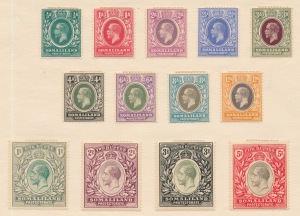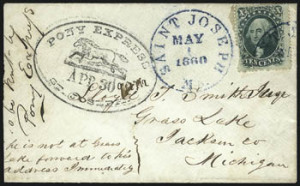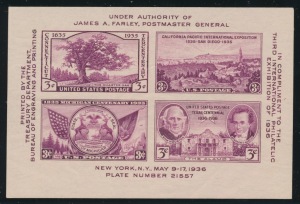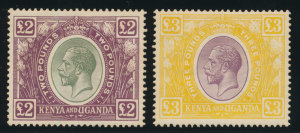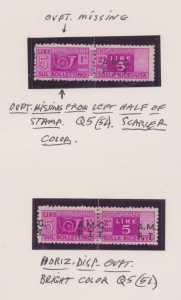Monthly Archives: April 2013
- Posted April 30, 2013Read more »One of the great changes in the stamp world has been the extinction of a species of philatelic professional called the Satchelateer. This type of dealer was common in the early part of the twentieth century and began to decline in numbers around 1980. Satchelateers (and the word is formed from "satchel" which is a large bag) were an important part of the stamp world for nearly one hundred years. They operated somewhat as wholesalers and somewhat in the way that re-insurers do. Here's what they did
- Posted April 29, 2013Read more »On Sunday April 28, 2013, the cover photograph of the New York Times Sunday Book Review was the sheet of the 8
- Posted April 26, 2013Read more »Certificates of genuiness grew out of dealer guarantees. Until about 1900, the pool of stamps that there was to collect was so small that the more reputable dealers knew them cold. True too was the fact that the great forgers of the twentieth century (Fournier, Sperati, and De Thuin) had not yet begun their work. In a small collecting environment, peddling forgeries was not very easy. Most forgeries are not visually very convincing. When a dealer or collector has seen numerous examples of the genuine stamp, the forgeries just look wrong to them without having to go to a reference collection to compare them to the known genuine. The early dealers would sign their stamps on the back (usually an ink hand stamp), and such signatures exist on many stamps to this day and are often the best guarantee that a collector can have of the origins of his philatelic material.By about 1900, philately had become popular
- Posted April 25, 2013Read more »These articles that you are reading fall into three main types
- Posted April 24, 2013Read more »Rowland Hill's idea for pre-printed postage stamps, that acted as a sort of bearer certificate for a service purchased but not yet obtained, was not formed in a vacuum. Printed postage stamps were a new idea, but embossed revenue stamps (and even a few embossed postage stamps from the Italian area) had been around for a long time before 1840. Among the more interesting areas of the very specialized US Revenue field are the embossed revenues. These stamps were embossed designs that were placed on sheets of paper that then were used for legal documents, property transfers, contracts, and the like to indicate that the tax had been paid on these documents (it was embossed revenue stamps like these that were the physical dimension of the hated stamp tax act of 1765, that the British placed on the Colonies and was one of the factors that led to our rebellion). Embossed revenues allowed banks and attorneys to have a stock of forms on which
- Posted April 23, 2013Read more »Probably no area of US philately has changed more over the last century than the collecting of US plate blocks. Ours was the first nation to collect plate blocks, and really is still the only country that does (Canadian collectors, UN collectors and Israel collectors have small plate block contingents, but these are derivative from US collecting, mainly appealing to Americans whose interest has migrated away from US philately and don't represent an indigenous specialty of their own). We are so far away from it now that few are aware of why plate number collecting began in the first place. The great American experiment of outsourcing government services to private companies was tried before, and the postal story was one of the first. Before 1894, our Post Office contracted with private printers for printing and design of US postage stamps. Several companies were used through the nineteenth century. By the early 1890s, the Post Office was no longer convinced that the deal it was getting
- Posted April 22, 2013Read more »When an event has played out, it is often hard to see how it could have happened any other way. The first airplanes flew, but the limitations of early technology made them cumbersome affairs. Wing design was primitive, providing minimal lift. Materials that made up the plane were heavy compared to the structure they provided, and engines were weighty, generating far less power per pound of metal than do modern engines. All of this meant that though the early airplanes flew, they could carry little more than the pilot. Range of flight was short, not so much because of the probability of engine trouble, but because fuel was heavy, and there was a point at which carrying enough to fly a long distance meant that the plane was too heavy to achieve lift. There was no room on these early airplanes for mail, except for a few philatelic pieces that were carried as favors, or promotional items, or at very high postage prices.
- Posted April 19, 2013Read more »Scott Publishing Company has been integral to collecting stamps in the United States. J. Walter Scott was one of the first stamp dealers, and his publishing company and catalogs grew out of the full service stamp dealing company that he ran beginning in the 1860s. Scott was an innovator, and the Scott companies were great promoters of philately during our hobby's most expansive period.Albums were a natural progression from Scott's price list and were really no great innovation. By 1920, Scott was pretty much out of the stamp sales business and pretty much totally a publishing company. About 1930, Scott began a plan to invigorate our hobby and help it cross the threshold from a niche activity to a mainstream hobby. The primary vector for this was the Scott Specialty series of albums. Scott had been producing an International Album for many years. This was originally a single volume album for all the stamps
- Posted April 18, 2013Read more »Commemorative stamps are often issued for anniversaries. The first United States commemorative set was the 1893 Columbian Exposition issue. This set was sold in conjunction with the World's Fair type exposition that was being held in Chicago that marked the four hundredth anniversary of the European discovery of the New World. Later US commemorative sets continued this theme of honoring anniversaries of American discoveries, settlements, and expeditions. This pattern was repeated in the Trans-Mississippi Exposition issue of 1898, the Pan American issue, the Hudson Fulton series, and on and on through the 1920s. By the early 1930s, nearly every worthwhile event relating to the founding of American settlement had received philatelic honors.Even though stamp collectors have come to love commemorative stamps,the investment performance of the earliest commemoratives was initially problematic. The Columbian
- Posted April 17, 2013Read more »The philatelic history of Albania shows the effects of the domination of four nations on the Albanian people as well as the political aspirations of the Albania people themselves. As part of the Balkan area, Albania has had the misfortune to be subject to political and military intervention by the Turks, the Italians, the Germans, the Soviets, before finally, in the most modern period, having their own fate in their hands. (Don't forget, the political good fortune of the dozen or so Eastern and Southeastern European countries that became truly independent after the fall of the Soviet Union in 1992 was a historical anomaly. Most of the nations of this area have long been under foreign domination since the Roman Empire. We are apt to forget what wondrous times these are for worldwide freedom.)In the late nineteenth century, Albania was controlled by the Turkish Empire, and
- Posted April 16, 2013Read more »There are four major worldwide international catalogs (plus several smaller single area specialized catalogs such as Facit for Scandinavia and Zumstein for Switzerland, which are only issued for their home countries and whose publishers have no worldwide versions of their catalogs). German philatelists collect their stamps by the Michel catalog, which publishes a worldwide catalog in German, along with a highly specialized catalog of Germany and area. Yvert is the French catalog which does substantially the same thing for francophones, again with a specialized France and Colonies catalog. Gibbons is published in Great Britain and once was a worldwide catalog, though their most popular yearly offering is a British Commonwealth catalog that is the standard for collecting the former British Colonies. And in America, we have the Scott catalog, published every year in numerous (costly) volumes. It is only a matter of time, perhaps even in less than a decade, when the last of the annual
- Posted April 15, 2013Read more »Imagine a company, which like the Scott publishing company, (so dominant in United States philately) is preeminent as its national stamp publisher. As well as issuing a general worldwide catalog, they are especially known as the publisher of the national specialty catalog which is used by nearly all native philatelists and millions of foreign ones. But in addition to this, they also sell stamps (Scott stopped selling stamps and concentrated only on publishing over 70 years ago), are among the largest stamp sellers in the world, have an investment arm, actively promote stamps as an investment, are beginning to make inroads into the American market, have just bought Bid Start
- Posted April 12, 2013Read more »Despite the common perception that stamp and coin collecting are very similar, there are very few collectors who do both. Among youngsters, maintaining both types of collections is more customary, but at higher levels, it is very unusual to find people who are passionately devoted to both hobbies. Maybe it is unusual for any specialty collector in any field (say buttons) to be passionate about a seemingly allied collecting field (say, antique sewing thread), but the difference between philately and numismatics seems, to collectors in both fields, to be vast. We philatelists think of ourselves as scholarly and erudite
- Posted April 11, 2013Read more »If you like stamps and stamp history, working on old collections is one of the most interesting things that you can do. We recently purchased a collection that had been made in the 1930s and had been passed down through the generations with considerable care, if not interest, on the part of the new owners. The current owner is an 85 year old grandson of the original collector.The collection is interesting for two reasons. First, the original collector never used albums, but rather kept most of the stamps that he bought on the original lot pages as he purchased them over 80 years ago. The collector was a loyal George Sloane customer. His choice of dealers was a very good one. Sloane was the among the best of his generation, running a large auction house that most sold mostly US but also did a bit of British business. George Sloane is one of those dealers who has come down to us through his
- Posted April 10, 2013Read more »
Recently President Obama made a gaffe and was widely criticized for his statement regarding the appearance the Attorney-General of California, Kamala Harris. Most philatelists are middle aged men (in fact over 90% of serious collectors are male) and most of us no doubt don't see what the fuss is all about. The President described Harris as the most attractive Attorney-General in the country, a statement that he certainly meant as praise and with respectful admiration. But the latent sexism in his remarks is instructive to us philatelists, especially as we wonder why we haven't attracted more women to our hobby and to organized philately.
Sexism, like racism come in many forms and what Obama was displaying when he thought he was being complimentary, was really a more benevolent form of sexism. Ms Harris - Posted April 09, 2013Read more »Cover collecting did not begin at the same time as did stamp collecting. Philately had its start in earnest about 1860, and, really, until about 1910, cover collecting was something collectors did when they didn't have the time to wash the stamps they needed for their collections off the envelopes on which they had bought them (this is why so many earlier stamps are so much rarer on cover than off). In a few cases, such as Pony Express covers or Civil War Patriotics, much of the collecting interest had to do with the cachet on the envelope and the usage that the cover received (rather than the stamp) so that there were a few early cover savers. But serious postal history collecting had to wait until the efforts of Henry Gibson, Sr. Gibson was the first collector who looked for rare usages of stamps on covers and assembled a major collection that was sold in the early part of the twentieth century. It was his financial success as a cover collector that began the impetus for the second great
- Posted April 08, 2013
- Posted April 05, 2013Read more »When collectors rail about excess new issue stamps soaking up their collecting budget and leaving them with little to spend on older stamps, they are only part of a long tradition of collectors who have bought stamps for their collections that were issued for reasons other than postal need. Some of the most popular stamps in all of philately, the George V and George VI high values, fit this description. When they were first issued, the enormous face values of some of the stamps (even up to as much as 100 Pounds postage value, a sum equal to the average annual wage for a construction worker in 1920-1930, the years such stamps were being issued) cause dolorous denunciations in the philatelic press.The high pound value stamps were only issued for a few African and Asian colonies, and there was a shred of legitimacy to them. The countries, which included Kenya, Uganda, and Tanganyika and Ceylon, were
- Posted April 04, 2013Read more »One of the constants in history is the malleability of political boundaries. In America, we have become a bit inured to this fact because our own geography has been so steady, adding only Hawaii and Alaska to our country in the last century. But Europe is used to change, and nowhere in Europe has there been more change than in the Balkan area. Trieste is a city that lies at the end of the Adriatic and has had many masters during its history.Trieste began the stamp period as part of the Austro-Hungarian empire. As such, like any city in the empire, it used Austrian stamps. After WWI, Austria ceded the area that included Trieste to Italy, and the importance of Trieste as a commercial center declined. Trieste had been an important port city for Austro-Hungary
- Posted April 03, 2013Read more »Philatelic popularity began a long, measurable ascent about 1900. An historian can see the hobby taking off, and we know that the numbers of collectors increased because we see an increase in the number of philatelic magazines, in the quantity of different stamp albums, increased membership in collector societies and more stamp dealers. As these quantifiable measurements of the appeal of our hobby have fallen off in recent years, the idea that our hobby is losing adherents has been gaining traction. But the evidence is really not that clear.It is true that the number of APS members and Linn











